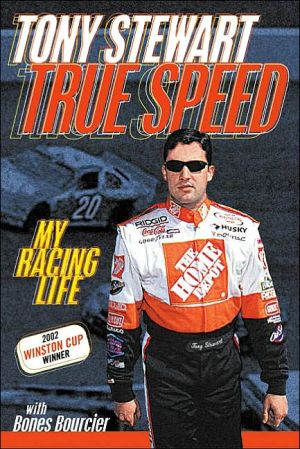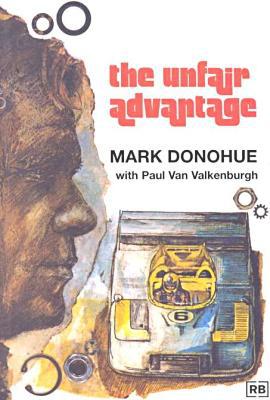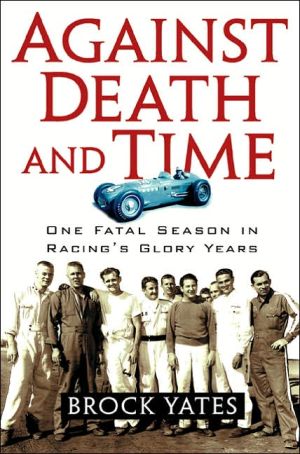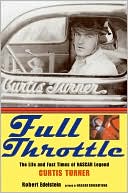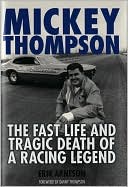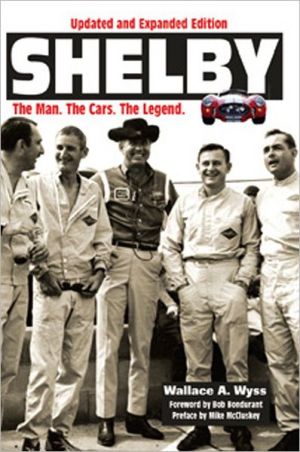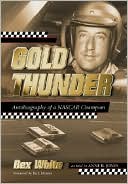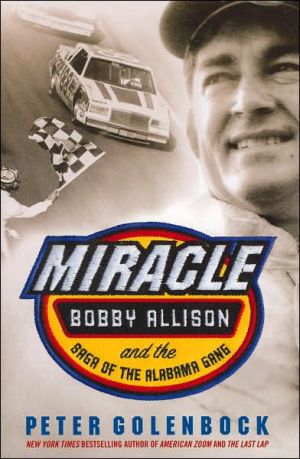True Speed: My Racing Life
The gritty inside story of a NASCAR champion.
Search in google:
The gritty inside story of a NASCAR champion. Publishers Weekly One of today's top race-car drivers, Stewart worked his way up from racing go-karts at small local tracks to racing open-wheel formula vehicles at the Indianapolis 500, finally becoming a champion NASCAR stock car driver. This autobiographical account, coauthored with noted racing journalist Bourcier, is interspersed with 75 black-and-white photographs and relevant quotes from people close to Stewart his mom, his girlfriend, members of his racing team, other famous drivers, and so forth. Having originally flourished in the South, NASCAR has become increasingly popular throughout the United States over the last decade. Still, 400 pages is a lot of text about a 30-year-old athlete, no matter how accomplished. Most editions of the Autobiography of Benjamin Franklin are significantly fewer pages and cover a much more interesting and important life. Despite these reservations, NASCAR fans will be interested. For sports collections. John Maxymuk, Rutgers Univ. Lib., Camden, NJ Copyright 2002 Cahners Business Information.
Chapter One\ \ \ Highs and Lows\ \ \ I have been to the top of the world.\ Well, the NASCAR world, anyway.\ It happened in February of 2001, after I'd won the Budweiser Shootout at Daytona, which is an all-star race for Winston Cup drivers held a week before the season officially opens with the Daytona 500. To be eligible, you have to have won a pole position in qualifying for one of the previous year's races. Obviously, there are no slow cars and no bad drivers in the Shootout, so it's a difficult race to win. The day I did it, it was extra difficult, because the guy I beat, the late Dale Earnhardt, had always been considered the master of that place.\ Actually, Earnhardt was the master of just about every track, but at Daytona he was the boss. He had won more races there -- thirty-four, in a number of different divisions -- than any other driver.\ When you win a race at Daytona, you go through the usual TV and radio interviews in victory lane, and then they load you into a van and drive you outside the track, to the base of the grandstands. From there, you jump into an elevator and ride up to the press box level for a much longer round of interviews. The press box sits so high, just towering over the racetrack, and it gives you a perspective of that place that you can't appreciate until you see it.\ Like I said, it's like being on top of the stock car world.\ From the time I was eight years old and racing go-karts, I have seen a hundred different tracks from ground level, looking over thesteering wheel. And I've been lucky enough to see a bunch of them from higher up, being interviewed in other press boxes and celebrating with sponsors in the VIP suites. Most of the time, it's just part of the job; a good part, yes, because you're usually up there for the right reasons, but part of the job anyway. You hang out for a while, and then you're anxious to get back down to the pit area to be with your guys, your teammates.\ But Daytona was different. I looked out at that famous old speedway, and I thought about all it has meant to stock car racing -- just to auto racing, period -- and I felt like I'd been crowned king for a day. I could have stayed there forever.\ Any win at Daytona is an accomplishment to cherish, but to beat Earnhardt there was an amazing feeling. The Shootout doesn't pay a million bucks to win, like the 500 does, but the fact that Dale ran second was something that couldn't be measured in dollars. In some ways it was sweeter to beat him in a race like this one -- a short sprint, where there's no holding back -- than to do it in a full Winston Cup event. In the Daytona 500, so much comes down to strategy and luck. In the Shootout, the only way to win is to just plain outrun 'em. And, obviously, Earnhardt wasn't an easy man to outrun.\ It's ironic: that day is so special to me because of who I beat, and yet during the final few laps I had mixed emotions about having to battle with Earnhardt. On the one hand, the guy had so much talent and experience -- hell, he'd won seven Winston Cup championships -- that you never worried about him getting you into trouble. On the other hand, all that talent and experience was lined up against me.\ At Daytona and Talladega, the biggest tracks in the series, NASCAR keeps the speeds down by reducing horsepower with restrictor plates that limit the air flowing through the carburetor. It's a safety thing; once these cars start crashing at over two hundred miles per hour, it's hard to figure out where they're going to land. What we end up with are 190-mph cars that feel extremely underpowered, like the go-karts at your local recreation center. We run around those two tracks wide open, holding the throttle down for the entire lap. The only way to gain speed is by drafting, taking advantage of the aerodynamic wake; the lead car punches a hole in the air, and the cars behind him kind of tag along, getting a free ride because they're essentially rolling through still air. You can follow a guy -- ride in his draft -- all day long, or you can use the draft as a passing tool: lay back a bit, then close on him until you sense that you've got enough momentum to swing out and pass him. It sounds simple, but it's not; drafting is a tricky, mysterious game.\ It takes awhile to learn exactly how the air moves: where the calm spots are, and where the wind will swirl and buffet your car, slowing you down. Some guys never figure it out. But Earnhardt elevated drafting to an art. Around the garage area, they used to claim that Dale could see the air.\ All I was seeing, when I found myself leading with three laps to go, was the black hood of his number 3 car in my mirror. Getting closer.\ He passed me as we got to turn three, like I knew he would, and I'm sure most of the people in the grandstands figured, Well, that's that. Once Earnhardt had the lead at Daytona, it was supposed to be impossible to get it away from him.But, you know, if I had backed down and surrendered every time somebody told me something was impossible, I'd still be back in Indiana, working a dead-end job and maybe racing part-time, and no one outside my hometown would even know my name. Because, see, I heard that it was...\ True Speed. Copyright © by Tony Stewart. Reprinted by permission of HarperCollins Publishers, Inc. All rights reserved. Available now wherever books are sold.
\ From Barnes & NobleThe Barnes & Noble Review\ A burning desire to race -- anytime, at any venue, and in any make of car -- has distinguished Tony Stewart as a throwback in the world of auto racing. Complementing Stewart's burning desire to race is a blazing speed and a red-hot temper. In True Speed, Stewart describes his progression to the top of the auto-racing world while attempting to defuse the controversy surrounding him. \ Though an Indiana boy, Stewart was from the beginning hooked on wheels rather than hoops. A precocious racing talent, he graduated from Go-Karts to sprints and midgets, finally to stock cars and Indy cars. Though he has excelled at all levels, he has never made up his mind on which he prefers: Stewart has a habit of racing both the Indy 500 and Charlotte's Coca-Cola 600 on the same day. Between Winston Cup runs with Joe Gibbs's racing team, Stewart may sneak out on a Saturday night for a local short-track event.\ Though he's a blue-collar hero and a genuine Everyman, Stewart's celebrity status makes a normal lifestyle impossible. Like all elite athletes, his single-minded focus and extraordinary competitive drive give Stewart a perspective alien to most people, and this has landed him in some scrapes with other drivers and with the press. At times, his temper erupts, and he's generally unwilling to blunt his honesty. One could argue that Stewart needs a good PR man -- what better vehicle to serve such purposes than an autobiography? (Brenn Jones)\ \ \ \ \ \ Publishers WeeklyOne of today's top race-car drivers, Stewart worked his way up from racing go-karts at small local tracks to racing open-wheel formula vehicles at the Indianapolis 500, finally becoming a champion NASCAR stock car driver. This autobiographical account, coauthored with noted racing journalist Bourcier, is interspersed with 75 black-and-white photographs and relevant quotes from people close to Stewart his mom, his girlfriend, members of his racing team, other famous drivers, and so forth. Having originally flourished in the South, NASCAR has become increasingly popular throughout the United States over the last decade. Still, 400 pages is a lot of text about a 30-year-old athlete, no matter how accomplished. Most editions of the Autobiography of Benjamin Franklin are significantly fewer pages and cover a much more interesting and important life. Despite these reservations, NASCAR fans will be interested. For sports collections. John Maxymuk, Rutgers Univ. Lib., Camden, NJ Copyright 2002 Cahners Business Information.\ \ \ Library JournalOne of today's top race-car drivers, Stewart worked his way up from racing go-karts at small local tracks to racing open-wheel formula vehicles at the Indianapolis 500, finally becoming a champion NASCAR stock car driver. This autobiographical account, coauthored with noted racing journalist Bourcier, is interspersed with 75 black-and-white photographs and relevant quotes from people close to Stewart his mom, his girlfriend, members of his racing team, other famous drivers, and so forth. Having originally flourished in the South, NASCAR has become increasingly popular throughout the United States over the last decade. Still, 400 pages is a lot of text about a 30-year-old athlete, no matter how accomplished. Most editions of the Autobiography of Benjamin Franklin are significantly fewer pages and cover a much more interesting and important life. Despite these reservations, NASCAR fans will be interested. For sports collections. John Maxymuk, Rutgers Univ. Lib., Camden, NJ Copyright 2002 Cahners Business Information.\ \
